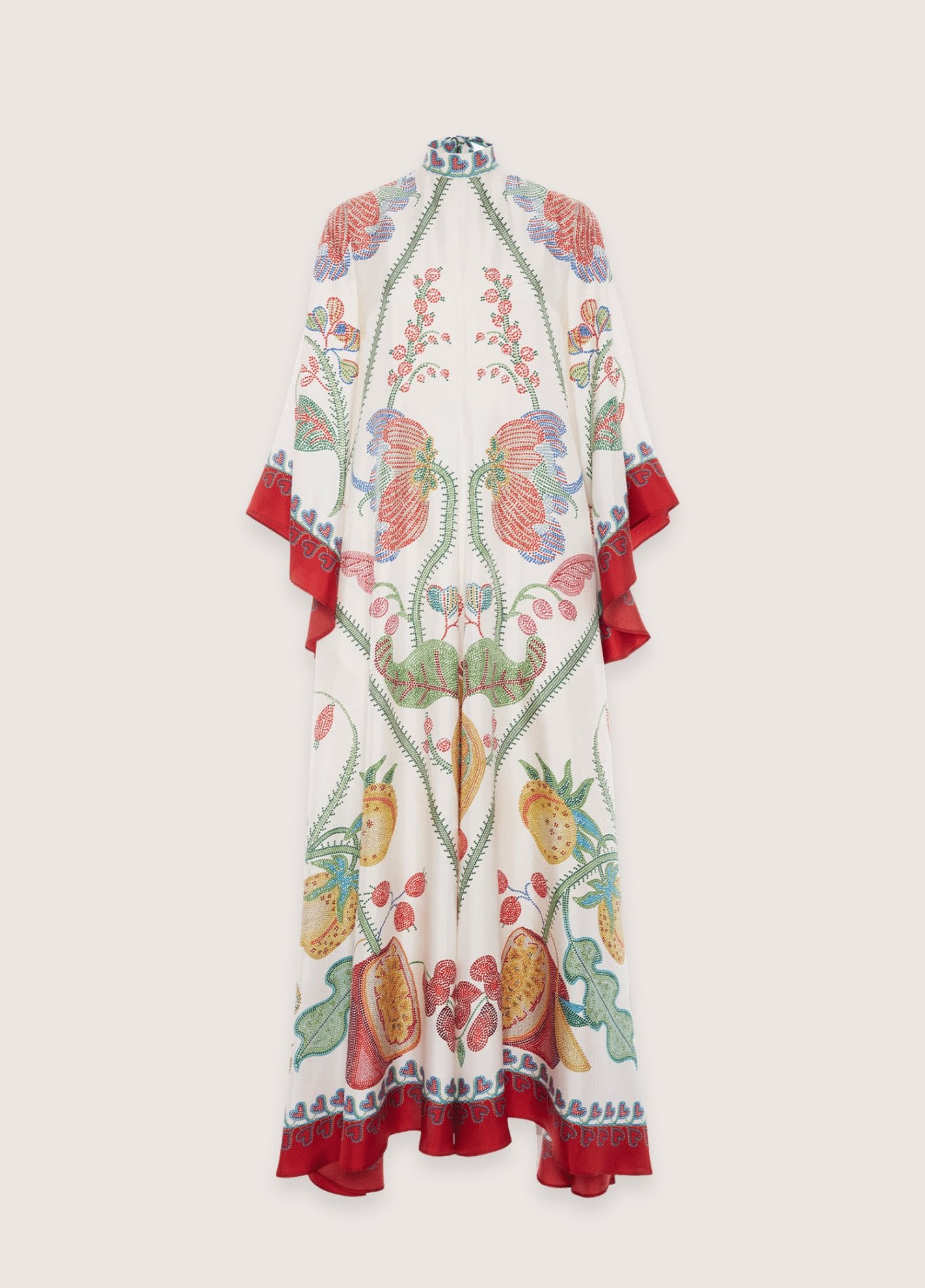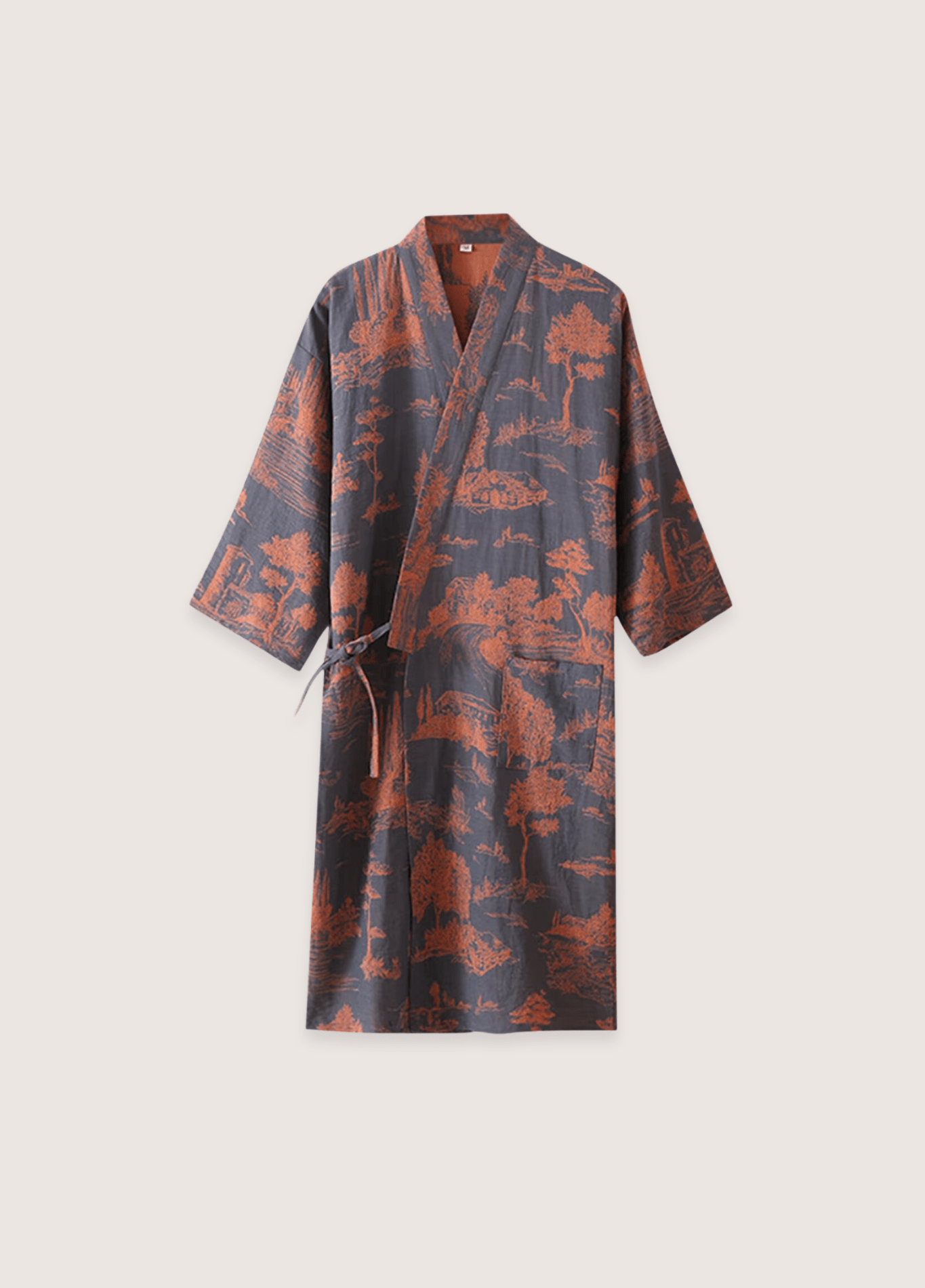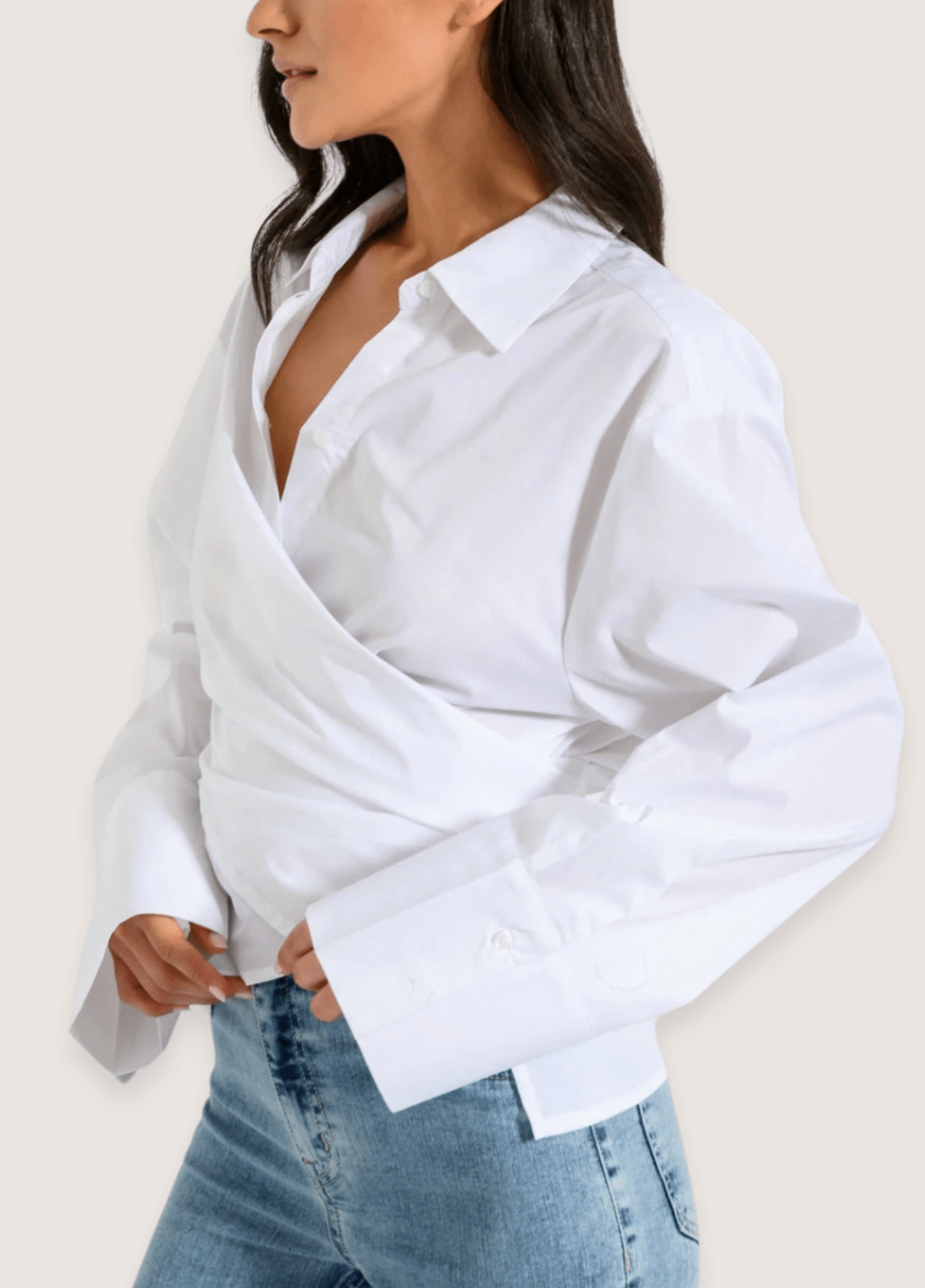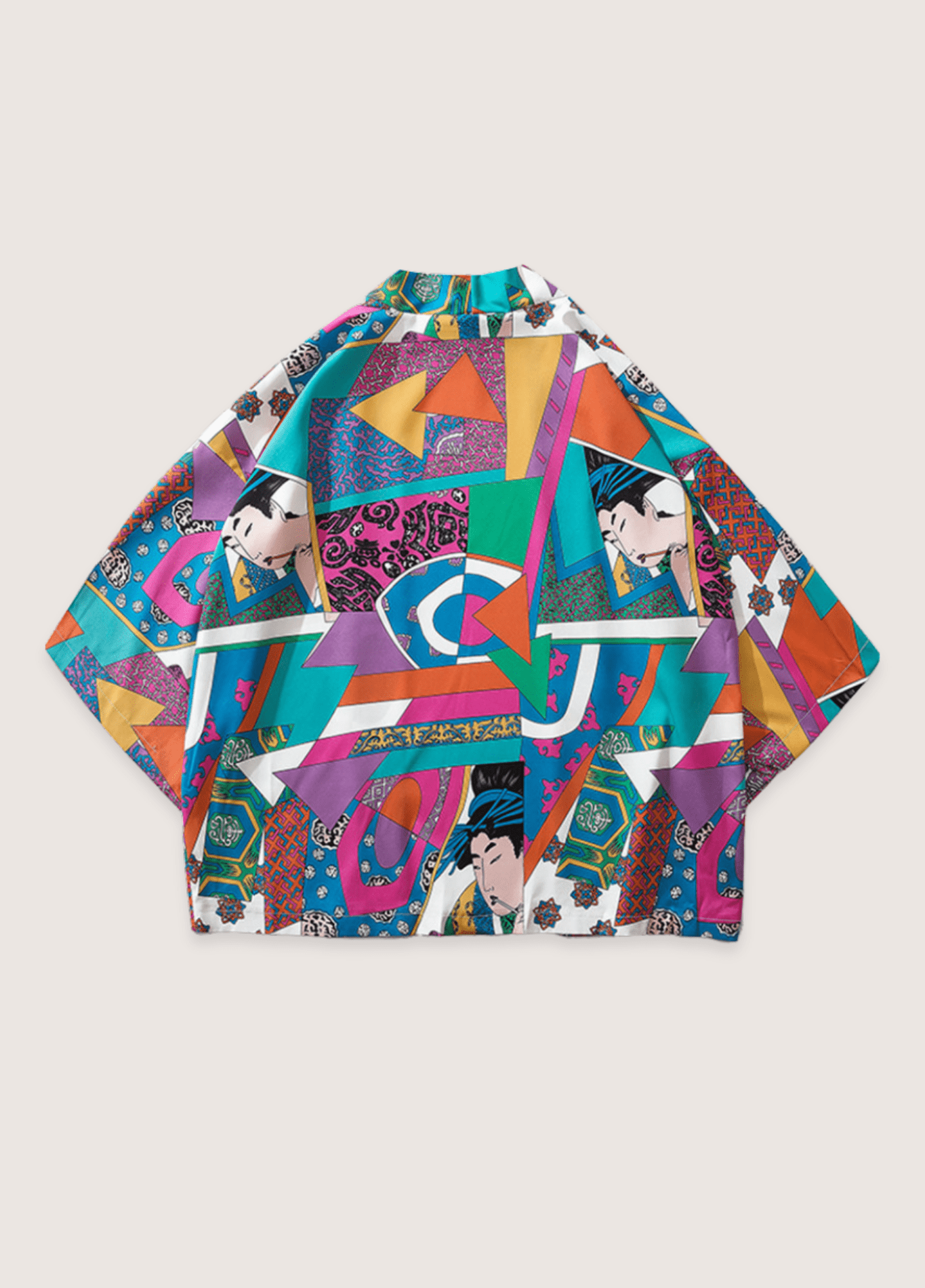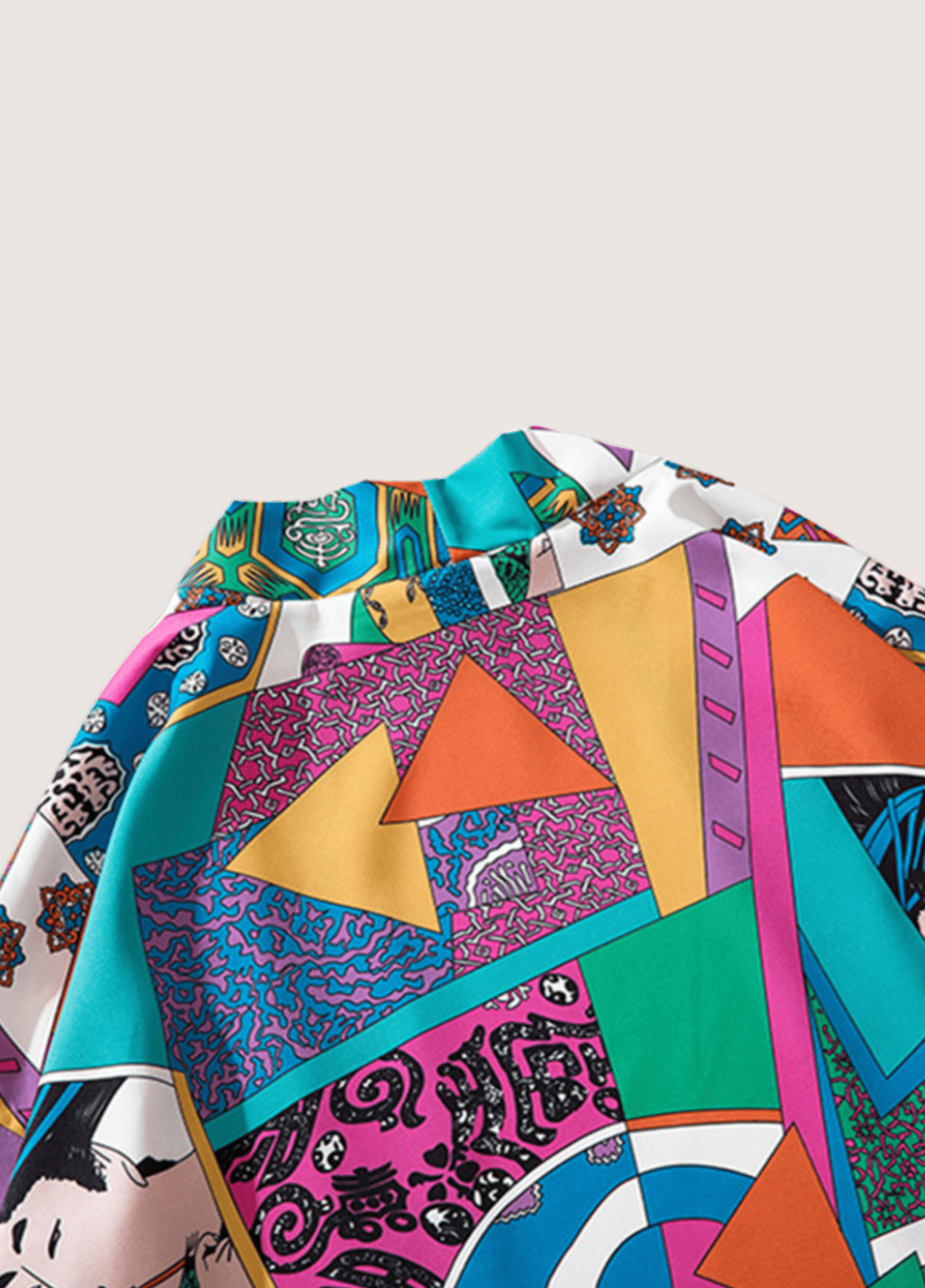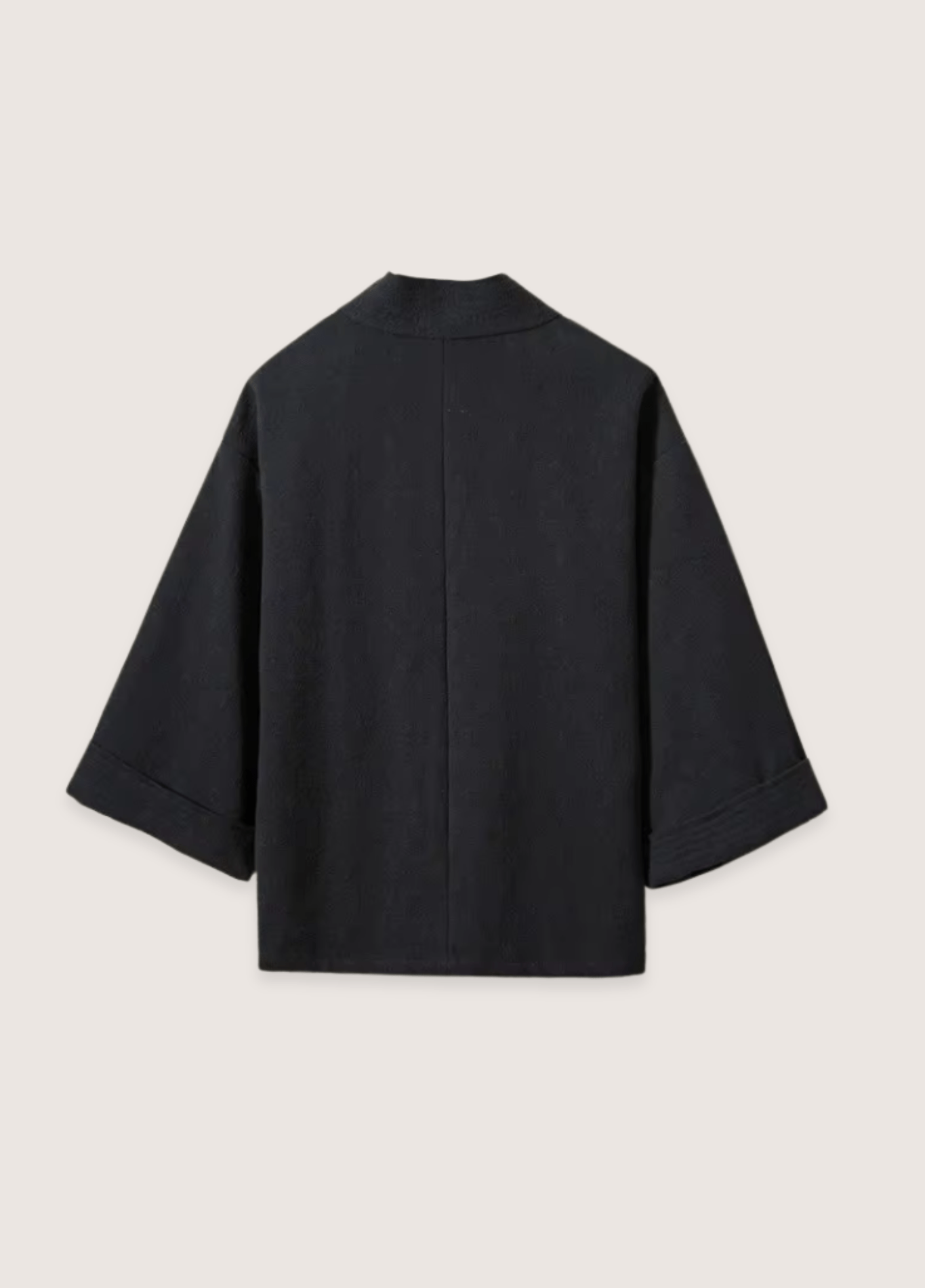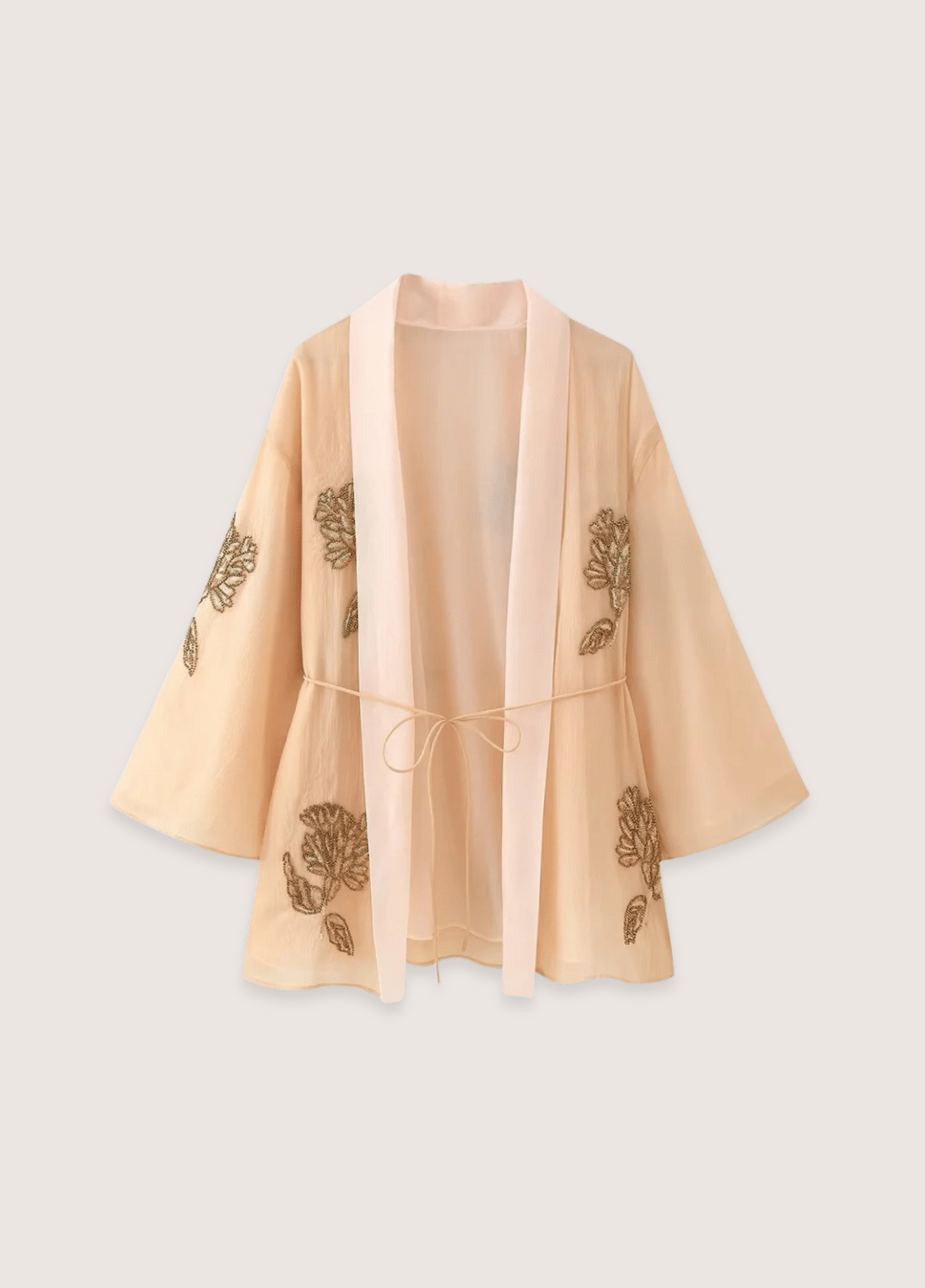In the spring of 1854, Commodore Matthew C. Perry of the United States Navy succeeded in signing a treaty of commerce and friendship with the Japanese shogunate, opening a door to an exotic country that had remained resolutely closed to the Western world for two and a half centuries of voluntary isolation. After the signing of the concessions, a mutual and elaborate exchange of gifts took place: the treaty house in the port of Yokohama was filled with delicate lacquered furniture, rich silks and embroidery, porcelain, fans and pipe boxes.
As the Commodore prepared to leave, Japanese officials informed him that there was still one item for the President of the United States that had not yet been presented, and they led him to the beach, where several hundred huge sacks of rice were piled up, ready to be loaded aboard the American ships.
"As I contemplated these concrete proofs of Japanese generosity," notes Francis L. Hawkes, the official chronicler of Perry's expeditions, in his report to the U.S. Congress,
The attention of all was suddenly drawn to a mass of monstrous male bodies, which were strolling along the beach like a herd of elephants. They were professional wrestlers, who were part of the retinue of the princes, who kept them at their side for their own amusement or to entertain the crowds. There must have been about twenty-five of them, and they were absolutely gigantic in stature and enormous in weight. Their costume was reduced to its simplest expression - a simple strip of cloth passed around the waist, enhanced with fringes and bearing the coats of arms of the princes to whom each belonged - and it showed their gigantic measurements bulging with fat and muscle.
The princes—called daimyo, or provincial lords—who accompanied the wrestlers then had them move the sixty-kilogram sacks of rice to a location closer to the ship as a first demonstration of the wrestlers' strength . The Japanese officials then suggested that the commodore and his followers retreat to the treaty house, where they would have the opportunity to watch the wrestlers exhibit their professional prowess.
Commander Mac Cauley of the Powhatan described the fights in his journal: "It was a very frustrating display of power, there were one or two falls, but they would have made every wrestler I have ever known burst out laughing."
Sumo , however, is much more than just a sport. It is a ritual of timeless dignity and classical formalism . It is a snapshot of the past, of Japanese history. The frequent interactions with the beliefs of the Shinto religion and the practices of the early centuries of the Christian era have left their deep and indelible marks on the sport.
Summary:
What is the salary of a sumo wrestler?
Who is the biggest sumo wrestler in the world?
What is the life expectancy of a sumo wrestler?
What is the maximum weight of a sumo wrestler?
Women in Sumo
History, rites, traditions
The beginnings of professional sumo
Japan's National Sport
Sumo Today
Organization and tournaments
What is the salary of a sumo wrestler?
| Rank | Salary 70s (¥) | Salary 70s (€) | Salary 2024 (¥) | Salary 2024 (€) |
| Yokozuna | 373,000 | ~2.350€ | ¥2,820,000 | ~17.750€ |
| Ozeki | 294,700 | ~1.855€ | ¥2,347,000 | ~14.775€ |
| Sekiwake/Komusubi | 200,300 | ~1.260€ | ¥1,693,000 | ~10.660€ |
| Maegashira | 137,600 | ~865€ | ¥1,309,000 | ~8.240€ |
| Jury | 114,500 | ~720€ | ¥1,036,000 | ~6.520€ |
Source: Japan Sumo Association (2024) and Inside Sport Japan
In addition to these basic salaries:
- Victory bonuses per fight
- Bonuses for the championships
- Special rewards (technique, combativeness, performance)
- Sponsorship income for the most famous
- Bonuses for kinboshi (victories against a yokozuna)
The lower divisions (below juryo) still only receive bonuses per tournament, as in the 70s.
Who is the biggest sumo wrestler in the world?
In the 1940s and 50s Azumafuji weighed nearly 190 kilos.
The record is now held by Orora 大露羅 with 292.6 kg .
Yamamotoyama (山本山) is the heaviest Japanese sumo wrestler of all time at 277kg.
What is the life expectancy of a sumo wrestler?
According to a 2009 study published in the Annals of Internal Medicine, the average life expectancy of sumo wrestlers is 60–65 years , 20 years less than the Japanese average.
What is the maximum weight of a sumo wrestler?
The maximum weight is not regulated. Only a minimum of 77 kg is required to become an apprentice.

Women in Sumo
Women's sumo, or Onna-zumo, emerged in brothels in Osaka's gay district during the Genroku period. In the 1760s, combined bouts between blind men and women began to appear. An edict in 1873 banned bouts between blind men and women, but bouts between women continued. Around the middle of the Meiji period, women's sumo was presented at Eko-in, but the performance was immediately banned. The wrestlers withdrew to Yamagata Prefecture and continued in the provinces. During a 1926 exhibition in Asakusa with a male participant, women's sumo was permanently banned in Tokyo.
Today, while women's sumo is not considered "authentic" by most Japanese and remains banned in professional settings, it does exist at the amateur level. The International Sumo Federation authorizes women's competitions, including at the World and European Championships. The rules are identical to men's amateur sumo, with two differences: wrestlers wear a leotard under their mawashi, and bouts last three minutes maximum instead of five.
The first national amateur women's championship was held in 1997. The sport has been the subject of several cultural works, including films, TV series and manga, reflecting a growing interest in a sport that continues to defy tradition. Hiyori Kon is a Japanese amateur sumo wrestler known for advocating for equal rights for women in professional competition in Japan. She was included in the BBC's list of 100 inspiring and influential women from around the world for 2019.
History, rites and traditions
Sumo, like many other aspects of Japanese culture, finds its roots in the Asian continent. The Japanese islands form an arc to the northeast of the continent, and are close to land at their northern and southwestern ends.
Japanese wrestling may have originally incorporated elements of Mongolian or Korean origin. Tombs in the Tung-kou region contain some very lively frescoes, including the "Tomb of the Wrestlers", dating from the 6th century, in which scenes of wrestlers fighting for the pleasure of noble guests can be seen on two of the walls. The figures are dressed only in cloth belts.
Chinese influences are better established. Records of wrestling in China date back to the Chou Dynasty (1030-221 BC). Until the 10th century, wrestling was commonly known as chiao-ti or chiao-li, written in characters meaning strength and horns. Chiao-ti originally referred to a brutal variant of ritual confrontations held at rural festivals.
The first written records of sumo appear in the Kojiki (Book of Ancient Usages, 712), which records the wrestling match between Takemikazuchi no Kami, a deity, and Takeminakata no Kami, son of the governor of Izumo . The choice of wrestling as a means of establishing the supremacy of the "divine" Yamato race confirms that in ancient Japan wrestling was commonly seen as a means of determining the will of the gods.
Important ritual traditions still exist today, such as the dohyo matsuri, or circle ceremony, which takes place in the fighting area on the morning of the day before a tournament opens. Three referees in white robes intone the age-old ritual that is meant to consecrate the fighting circle and call upon the gods to protect the wrestlers from injury in the upcoming bouts.
Sumo , however, has undergone periodic mutations in its rules, costumes, and even its name as it has adapted to the storms of politics and cultural vicissitudes since its prehistoric origins in Shinto divination. The primal form of wrestling is called chikara kurabe, or test of strength, while in early feudal times it was called sumai, a martial technique aimed at bringing an enemy to the ground in order to capture or decapitate him.
It is the constant interplay between sacred and secular legacies – the observance of rituals combined with the incredible spectacle of giants weighing over 150 kilos clashing – that makes this indigenous form of wrestling the national sport of Japan.
Asian Origins & Influences
While the Ainu tribes, now found only in small numbers on the northern island of Hokkaido and Sakhalin, appear to be of Indo-European origin, the Japanese are in fact a Mongoloid race mixed with southern Chinese and Indonesian blood.
Japanese wrestling was particularly influenced by Korea from the 6th to the 8th century, as evidenced by tomb excavations at Takamatsukusa in Nara Prefecture. The "Tomb of the Wrestlers", dating from the 6th century, shows scenes where the wrestlers are dressed only in cloth belts, using Mongolian-like techniques strikingly similar to early descriptions of sumo.
Chinese influences are even more documented . In the Sui Dynasty (590-618), chiao-ti was set according to the lunar calendar on the fifteenth day of the first month. In the T'ang Dynasty (618-906), emperors held sumptuous banquets with chiao-ti. A chronicle records that "after various performances and numbers, the officers of the left and right guards beat the drum, and strong naked men lined up and engaged in a showdown to decide the winner."
First archives
Although sumo has some roots in the Asian continent, it has never denied its origins. In the ancient Yamato region, excavations of ancient burial mounds have uncovered haniwa (clay figurines) of wrestlers. The first written mention of them is in the Kojiki (712), which records the fight between Takemikazuchi no Kami and Takeminakata no Kami.
The Nihongi (Chronicles of Japan, 720) also mentions the first Japanese word for wrestling, chikara kurabe. A legend describes how two champion wrestlers, Nomi no Sukune of Izumo and Taima no Kehaya of Yamato, were summoned to the Yamato court. Sukune then broke Kehaya's ribs and kidneys with a violent blow, killing him.
Rural traditions and rituals
Sumo performed as a religious ritual during a festival is known as shinji-zumo, or thanksgiving sumo. Early celebrations were almost always timed to fit the agricultural calendar and tied to rice production.
Many rituals still exist today. At Hakui Shrine, wrestlers compete between "those at the top of the mountain" and "those at the bottom of the mountain", with the victorious region supposedly securing the best harvests.
Another important tradition is konaki-zumo, or crying baby sumo. According to the proverb "a crying child will be well," two children are presented face to face, with the first one to cry being declared the winner.
Popularization
During the Heian period (794-1185), the imperial family and court nobility spent most of their year in ceremonies and rituals. The fights were presented between the "left" and the "right." Wrestlers hired by the left office of the imperial guard became the hidari-gata, while those chosen by the right office became the migi-gata.
The wrestlers wear wide bands of cloth called tosagi on their foreheads. Short swords are stuck into the sides of their loincloths. To distinguish the wrestlers, those on the left wear paper roses in their hair, while those on the right wear gourd flowers.
The splendor and frequency of wrestling banquet tournaments began to decline from the end of the 10th century, with the decline in the power of the imperial court. Banquet tournaments disappeared between 1120 and 1156, when they were temporarily revived by Emperor Goshirakawa. Tournaments were held in 1174 and finally in 1185, but by this time the tournaments had lost most of their prestige.
The beginnings of professional sumo
In 1615, Ieyasu, who had been granted the ancient title of shogun by the Kyoto court in 1603, established a system of strict control over the daimyo and their private estates. Toyotomi Hideyoshi had decreed a freeze on social status in 1590, prohibiting all mobility between classes and banning the carrying of weapons by peasants. Ieyasu extended these regulations, and the samurai were now considered to be of a much higher status than that of citizens.
Early 17th-century Edo was a ruthless city. Samurai from the lords' retinue, unemployed ronin, and bandits from the peasant class strutted side by side through the city streets. The public disorder that resulted from the wrestling spectacles became serious enough to force the Edo authorities to take action. In 1648, the city magistrate issued the following bans:
- Street sumo is banned
- Charity sumo will no longer be held
- Wrestlers who are invited to perform at the residences of their superiors will no longer wear silk loincloths, but only cotton ones.
For over twenty years sumo was stagnant. To defend themselves, professional wrestlers and masterless samurai began to unite in informal coalitions. Finally, in 1684, masterless samurai Ikazuchi Gondaiyu was granted permission to hold an eight-day charity sumo tournament at the Fukagawa Shrine.
Official recognition comes when the organizers (kanjin moto) of charity tournaments are forced to obtain the proper permit documents from the head of the shrines. Placards reading gomen o komuru (permission granted) are put up at the entrance to the fighting areas.
It was in Osaka and Kyoto, not Edo, that the popularization of charity sumo began to bear fruit. Records of major tournaments in Kyoto in the late 16th century attest to its early development in that city. The hierarchy of the ranks of ozeki, sekiwake, and komusubi was established, and the banzuke (program) listing the names and ranks of the wrestlers was designed.
Leading wrestlers began to be supported by wealthy organizations in the mid-Meiji period. Two of the pioneers were the Hinoshita Kai (Champions Club) and the Banzai Club (Ten Thousand Year Club).
An important codification came in 1789 when Yoshida Oikaze submitted to the head of the Edo shrines a number of documents authenticating both his own authority over the sumo world and the supposed historicity of some of sumo's traditions. In particular, he was granted the power to issue what he called the yokozuna menkyo, or yokozuna license.
The decline of the Edo period saw the final years of the Tokugawa government, from 1853 to its fall in 1868, known as the Bakumatsu. Sumo shared the uncertainties of this end of the Edo period and took place in a muted manner. One of the major exploits was the participation of a group of miya-zumo (Shinto shrine sumo) wrestlers in the decisive capture of Shimonoseki during the Choshu Civil War in 1865.
The beginning of the Edo period
By the end of the 16th century, Hideyoshi had established a hostage system, requiring the wives and children of daimyo to reside permanently in his capital. In 1635, Ieyasu made this system mandatory. The lords built vast residences there and transferred their vassals to Edo, where a plebs of merchants and servants were created to serve them.
The early years of Tokugawa rule were marked by the large number of samurai who had lost their lords. These ronin were forbidden by law from joining the ranks of the lower classes. Sumo remained one of the few legal opportunities for activity during this period.
In 1648, due to public unrest, the city magistrate banned street sumo and charity sumo. However, even in the months following these bans, the Edo authorities finally permitted a six-day charity sumo spectacle for the opening ceremonies of the Sanjusangendo Temple.
Official recognition
In 1684, after many years of prohibition, Ikazuchi Gondaiyu was granted permission to hold charity sumo tournaments. His request included important innovations such as defining a wrestling area marked out by earth balls.
The circle (dohyo) itself dates from the late 1660s. The first illustration of a dohyo appears in a drawing made between 1673 and 1681. The term "dohyo" was used to refer to the sumoba (the fighting area) from the late 17th century. It is made of packed clay and enclosed in bales of rice straw.
Codification
In 1789, Yoshida Oikaze made a bold move by submitting documents authenticating his authority over the sumo world. In his biography, he claimed descent from a warrior named Yoshida Ietsuru.
He was granted the authority to issue yokozuna licenses, and in 1789 he bestowed the title upon champions Tanikaze Kajinosuke and Onogawa Kisaburo. Ten days later, Tanikaze executed the first yokozuna dohyo-iri within the grounds of Fukagawa Hachiman Shrine.
In 1791, a tournament was held in the Fukiage Gardens of the Edo Citadel. For this occasion, the Edo sumo elders drew up a complete set of rules and rituals. The dohyo itself was redesigned with complex symbolism that combined Shinto, Buddhism, and Confucianism.
The Decline of the Edo Period
The final years of Tokugawa rule (1853–1868), known as the Bakumatsu, saw a rapid decline in the authority of the central government in Edo, ending in the civil war that accompanied the restoration of imperial power.
A notable event was the participation of wrestlers in the Choshu Civil War in 1865. The Choshu feudal domain had formed a militia that included a troupe of wrestlers called the Rikishi Tai (Wrestler-Soldiers). These wrestlers participated in the capture of Shimonoseki, using their strength to lift oak beams rather than wielding swords, which they were not proficient with.
Although it suffered during the events leading up to the fall of the Tokugawa regime, sumo had become a favorite pastime throughout Japan by the 19th century . The wrestlers were national idols, and the government recognized the great importance of the sport. But it was with Japan's entry into the modern era that sumo would finally be recognized as the country's national sport.
I will start with the first three sections. Due to the length, I propose to divide the answer into several parts.
Japan's National Sport
In 1869, as Japan began its modernization, Emperor Meiji officially recognized the importance of sumo by selecting wrestlers to carry the imperial banners on his historic journey to the new capital of Tokyo. However, the political renovations of the Meiji Restoration undermined traditional sumo. The abolition of feudal domains and the seizure of land records by the emperor in 1869 swept away the authority and hereditary income of the daimyo, depriving wrestlers of their main patrons. The wave of Western modernization even threatened the existence of the sport, considered "barbaric" and "unworthy" of the new era. Fortunately, powerful groups in the highest circles of government power supported the preservation of the country's cultural traditions. It was through various reforms, the emergence of great champions, and the creation of a national organization that sumo would not only survive but establish itself as Japan's true national sport.
The Crisis of the Meiji Era
During the chaotic early years of the Meiji era, Edo—declared capital and renamed Tokyo in 1868—had more pressing concerns to attend to than sumo. However, in March 1869, when Emperor Meiji made his historic journey to the new imperial residence, wrestlers were chosen to march at the head of the procession and carry the imperial banners.
The abrupt end of the daimyo's influence came as a shock to the sumo world, which began to suffer from public censorship. As Western ideas emerged and were adopted almost without reservation, waves of "civilization" and "Enlightenment" swept over Japan. In elite circles, traditional costumes were preferred to the latest London fashions.
Drafts calling for the abolition of sumo are appearing in newspapers, and phrases such as "barbaric sumo must be banned" and "sumo's nudity is embarrassing" seem to be unanimous.
Reformation and Resurrection
A hot-headed wrestler named Takamiyama came to the forefront to urgently demand reform in the corrupt handling of the sumo association's finances. In 1870, following various incidents, he changed his name to Takasago Uragoro.
In 1873, Takasago and nearly forty other wrestlers revived the old reform movement. Expelled from the Tokyo Sumo Association, these outcasts formed their own group and performed in cities throughout western Japan. In 1876, they returned to Tokyo and established their headquarters in Kanda.
Following these reforms, the association's director and his deputy, along with two ozeki, examine the results of the fights to determine salary increases and decreases. Directors will now be chosen by elections.
The champions of the end of the 19th century
Umegatani Toutaro I, born in 1845, became a living legend. He was promoted to the rank of yokozuna in 1884 by the Gojo and Yoshida families. In early 1885, he was defeated on two consecutive days and decided to retire.
Odate Hane-emon was one of the most powerful wrestlers of the early Meiji era. He notably defeated Umegatani in 1884. Although his performances were excellent, he was not promoted to ozeki until he was 42 years old.
Nishinoumi Kajiro I, born in Kagoshima Prefecture, became yokozuna in 1890. For the first time, the word "yokozuna" was added next to his name on the official banzuke.
A national stadium
In 1909, the first Kokugikan, the national sumo stadium, was built in Tokyo's Ryogoku district, adjacent to the Eko-in temple grounds. The stadium was designed by Tatsuno Kingo, who also designed Tokyo Station. That year, the association also refined its rules, requiring makuuchi wrestlers to fight for ten days instead of nine. The referee's costume, previously the traditional ceremonial costume of the samurai, was abandoned in favor of the warrior's kimono and a black hat worn at court.

The National Sumo Association
Following discussions that had been ongoing since the early 1920s, the Tokyo and Osaka sumo associations were finally merged in 1925. To unite the various rankings, qualifying tournaments were held in November 1925 and March and October of the following year. With this merger, the Dai Nihon Ozumo Kyokai (All-Japan Sumo Association) was formed. It was formally registered as a non-profit organization in 1927 and placed under the supervision of the Ministry of Education.
Wrestlers of the new era
The following years saw the emergence of great champions such as Hitachiyama Taniemon, born in 1874, who became the 22nd yokozuna in 1911. He won eleven tournaments, five of them without conceding a defeat, and on one occasion won 54 consecutive fights.
Onishiki Uichiro became yokozuna in 1917, followed by Moriya Tochigiyama. Onishiki, known as the "founder of modern sumo," was remarkably well-read for a wrestler. He achieved the rank of ozeki in record time.
The Naked Ambassadors
In the 1960s, as Japan was once again becoming a major economic power, sumo played an important diplomatic role. In the summer of 1965, wrestlers led by Taiho, Sadanoyama, and Kashiwado toured the USSR at the invitation of the Soviet authorities. Hailed on both sides of the Iron Curtain as the "naked ambassadors," the wrestlers were received with great enthusiasm at the Moscow National Circus. Eight years later, in 1973, a similar group traveled to Beijing and Shanghai to celebrate the opening of Sino-Japanese diplomatic relations.
The world of sumo in the 70s
The 1970s saw the emergence of new stars such as Wajima Hiroshi, the first yokozuna to graduate from university, and Kitanoumi Toshimitsu. Kitanoumi broke Taiho's record by becoming the youngest wrestler to reach makuuchi and be promoted to yokozuna at the age of 21 years and two months. Sumo's popularity reached new heights, with the introduction of live television broadcasts and the expansion of tournaments to six per year.

Post-war chaos
In November 1945, the Kyokai received permission from the occupying forces to hold a ten-day tournament in the ruins of the Kokugikan. The dohyo was temporarily extended to sixteen feet in diameter, but was soon reduced to its traditional dimensions of fifteen feet. The Kokugikan was requisitioned by the occupying forces and renamed Memorial Hall, which was partially converted into an ice rink for American soldiers. Tournaments were held in temporary facilities until the new Kokugikan was built in the 1950s.
These difficult years nevertheless saw the emergence of great champions such as Maedayama Eigoro, the first post-war yokozuna, and Azumafuji Kin'ichi, the only yokozuna born in Tokyo. Sumo survived this troubled period and gradually regained its central place in Japanese culture.
Sumo Today
As Japan entered the 1980s, sumo's phenomenal popularity showed no signs of slowing. Interest in this feudal sport continued to grow at a rate that was inconsistent with the rate at which other vestiges of Japan's ancient culture were disappearing behind the glass and concrete facades of its economic growth. The world of sumo, along with the other spectacles of kabuki, bunraku, and noh, was considered one of the last bastions of the feudal customs of the Edo period.

Wrestlers and heya
The square kilometer south of Ryogoku Station in Tokyo has been known as the sumo district since the mid-Edo period. More than half of the thirty sumo heya, some of which were founded two hundred years ago, are scattered throughout this district. Life within the heya is based on traditions of absolute obedience and respect for superiors, developed and maintained over the centuries.
The ranks of the wrestlers
The system used to rank the approximately 600 professional wrestlers forms a pyramidal hierarchy. At the top is the makuuchi division, comprising the yokozuna, ozeki, sekiwake, komusubi, and maegashira for a total of 36 wrestlers. Below this comes the juryo (26 wrestlers), then the makushita (130 wrestlers), sandanme (180), jonidan (240), and jonokuchi (36) divisions. The differences in status between these ranks are enormous and determine the treatment, salary, and privileges of each wrestler.
Training in the heya
When a wrestler is not on tour or engaged in a tournament, daily training varies little. Apprentices rise at five in the morning to warm up in the keikoba. Exercises include shiko (leg lifts), matawari (splits), and teppo (punching a pillar). Practice bouts include moshiai (elimination) and samban-geiko (series against the same opponent). Training ends around 11:30 with butsukari-geiko, a grueling opposition exercise.

Elders and management of a heya
Oyakata, or masters, are former wrestlers who run the heya. To become an Elder, a wrestler must have participated in at least one tournament in the makuuchi ranks or have fought at least 25 tournaments, twenty of which must be in juryo. He must also acquire a very expensive Elder share (toshiyori kabu). Elders make up 105 of the members of the Japan Sumo Association and oversee all aspects of the professional sport.
From apprentice to yokozuna
A wrestler's journey begins with the entrance exam where he must meet minimum height (1.70m) and weight (77kg) criteria. He starts in maezumo then must earn "white stars" to move up to jonokuchi. Progression through the ranks then depends solely on tournament results. To become yokozuna, the highest possible rank, a wrestler must win two successive tournaments as ozeki and demonstrate exemplary character.
Wages
A monthly salary system has existed since 1957, but only sekitori (juryo and makuuchi) benefit from it. Wrestlers in the lower divisions only receive per-tournament bonuses. By the late 1970s, a yokozuna earned about ¥373,000 per month, an ozeki ¥294,700, a komusubi or sekiwake ¥200,300, a maegashira ¥137,600, and a juryo ¥114,500, plus various additional bonuses.
Wrestlers Names
Shikona (wrestler names) follow a long tradition dating back to feudal times. The first appeared when samurai without masters adopted pseudonyms to preserve their reputation. The names could be inspired by birthplaces, natural phenomena, animals or take part of the master's name. Some heya had special names reserved for champions, such as Kashiwado for Isenoumi-beya.
Organization and tournaments
The Japan Sumo Association (Nihon Sumo Kyokai) holds six major annual tournaments, or basho, each lasting fifteen days. Three are held in Tokyo (January, May and September) at the Kuramae Kokugikan, the others in Osaka (March), Nagoya (July) and Fukuoka (November). The daily routine is meticulously regulated, starting at dawn with the lower divisions' bouts and culminating in the late afternoon with the champions' bouts.
The bouts are organized by a committee that publishes the schedule the day before. Wrestlers are divided into East and West, a tradition dating back to the Edo period, although this division has been purely administrative since 1947. The winner of a tournament (yusho) receives the Emperor's Cup and numerous trophies. Special prizes also reward technique (gino-sho), fighting spirit (kanto-sho), and performance (shukun-sho) for wrestlers below the rank of ozeki.
A complex system of promotion and demotion (banzuke) is applied after each tournament. A wrestler must generally win more than half of his matches (kachi-koshi) to hope to move up in rank, while a negative score (make-koshi) can result in demotion. Decisions are made by a committee of Elders who evaluate the performances of each wrestler.
The tournaments are also the occasion for important ceremonies, such as the dohyo-matsuri (consecration of the circle) on the eve of the first day, and the yumitori-shiki (bow ceremony) which closes each day. These rituals, inherited from the Edo period, underline the sacred nature of sumo and its deep connection with the Shinto religion.
Kokugikan
Tokyo tournaments are held in the Kokugikan, the national sumo stadium in the Kuramae district. Outside the main entrance, there are about twenty small food stalls lined up on both sides of a long covered corridor. These teahouses are assigned entire rows of the best seats in the hall, which they resell to regular customers. Tickets for the boxes, known as sajiki or masseki, are nearly impossible to obtain without the right connections. The price of a seat in one of these four-person boxes is about ¥10,000, including refreshments and souvenirs. Waiters, called dekata, many of whom are farmers from around Tokyo, crowd the corridors during the bouts, guiding customers to their seats.
The dohyo
In the very center of the hall is the dohyo, a two-foot-high, six-foot-square pile of clay so compacted that building a new one requires seven semi-trailers of dirt. The surface is covered with a light layer of sand, a symbol of purity in Shinto rituals that also helps determine whether a wrestler has stepped outside the circle by a footprint. Oblong bales of rice straw filled with dirt mark an inner circle about four and a half meters in diameter. One bale is placed slightly outward at each of the cardinal points for the historic drainage of rainwater. Above the dohyo hangs a Shinto-style roof, its four corners decorated with enormous silk tassels representing the seasons: blue for spring, red for summer, white for fall, and black for winter.

The referees
Directing and refereeing a fight is the task of the gyoji, who also presides over ceremonies and rituals. Gyoji wear thick silk kimono of a type used by samurai and a black hat of the imperial court. They are ranked by seniority and skill, the highest rank being that of tate gyoji, the only one authorized to direct yokozuna fights. Each gyoji carries a war fan whose tassel color indicates his rank: purple for the highest ranking, red for those refereeing sanyaku, blue and white for juryo, black and blue for the lower divisions. They all belong to the Kimura or Shikimori lineages, recognizable by the way they hold the fan during announcements.
Clothes
On the dohyo, wrestlers wear only a thick strip of colored silk (cotton for the lower divisions) called mawashi. Measuring about 90 centimeters wide and up to twelve meters long, it is folded six times widthwise, wraps around the waist and is tied at the back. Tucked into the bottom is a belt carrying the sagari, usually 19 strips of starched silk (always in odd numbers because they recall the sacred ropes of Shinto shrines). The mawashi is the key to most of the 70 official techniques for defeating the opponent.
Dohyo Entrance Ceremonies
Just before the sekitori bouts, the wrestlers perform the dohyo-iri, the entrance ceremony. Wearing richly embroidered aprons given by their patrons, they step onto the dohyo preceded by a referee. After their introduction at the microphone, they form a circle facing the audience. At the signal, they turn around, clap their hands (a purification ritual), raise their arms and aprons, and then withdraw. The yokozuna then perform their own ceremony, the dezu-iri, wearing an imposing white rope tied around their waists, accompanied by a tsuyu-harai (herald) and a tachi-mochi (sword bearer).
Makuuchi Fights
The bouts begin with the announcement of the wrestlers by the yobidashi. Purification rituals with water (chikara-mizu) and salt follow. The wrestlers crouch for the shikiri, a waiting position limited to 4 minutes for the makuuchi. The initial charge (tachiai) is explosive, and the bouts are generally brief but intense. The judges, former champions seated at the four corners of the dohyo, can challenge the referee's decisions during a mono-ii (deliberation). The winner receives his rewards on the referee's fan and remains to offer water to the next fighter.
Schedule
The year includes six major tournaments: January, March, May, July, September, and November. Between these tournaments, wrestlers participate in provincial tours (jungyo) organized by the Kyokai. These tours are particularly demanding for the apprentices, who must set up and take down facilities, carry luggage, and serve the sekitori. Wrestlers only have a week's rest after each tournament, often followed by charity bouts (hana-zumo) or retirement ceremonies (intai-zumo).
Heya
The thirty heyas varied in size and prestige. The largest, such as the Dewanoumi-beya founded in the 18th century, produced many champions and naturally attracted more patrons and promising recruits. Each heya maintained close ties with others, forming "families" that influenced in particular the organization of fights to avoid clashes between wrestlers from related heyas.
The list of yokozuna
The rank of yokozuna remained a mere honorific until 1909. The first official list was compiled by former yokozuna Jinmaku Kyugoro in 1895, who faced much controversy over the historical first yokozuna. The list traditionally begins with Akashi Shiganosuke, although the first officially recognized yokozuna was Tanikaze in 1789. Numbers are assigned chronologically, and in the case of simultaneous promotion of two yokozuna, the order is determined by the date of their retirement.
Learn more about the origins of the kimono and Shōgun: The series that brings feudal Japan back to life


